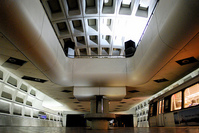Metro budget gap now $175 million
Metro’s budget gap has risen $37.5 million beyond the previous estimate to a total of $175 million, which will force large fare increases and service reductions, according to the presentation that the WMATA Board will receive today.
A Fox 5 reported a set of specific fare increase proposals, including raising the bus fare from $1.25 to $1.50 and increases in rush hour and off-peak rail fares including an increase of the maximum fare (for the longest-distance trips) to $5.00. The final presentation to the WMATA Board of Directors does not contain these specifics, but rather says that staff will present specific fare proposals along with service cut recommendations later in December.
The Fox list also contains a 10¢ surcharge for “peak of the peak” rail trips between 8 and 9 am and 5 and 6 pm. Michael and I have been pushing for this, especially since it creates an incentive for people to ride outside the most crowded hour. Fox reports that would raise $5 million a year. That was part of the list cut out of the final presentation, but there’s still a bullet point early on, noting this as one of the ideas suggested by riders at the town halls. (I brought it up, as did Kevin Moore).
Fox says that declining ridership from the recession is the primary cause of the budget gap. That’s based on a misreading of the presentation. The decline in ridership is the primary cause of the new, additional budget gap, cutting revenues by $23.29 million; expenses also rose in paratransit (from growing demand), insurance, and other areas, offset somewhat by lower fuel costs. Metro is entering into long-term fuel contracts to lock in lower prices for future years and reduce uncertainty.
The bulk of the budget gap itself comes from the sources reported earlier: higher labor costs, especially health care and pensions, rising paratransit ridership, and increased costs like insurance. Pension payments will rise 24%, which is much less than once feared because the arbitrator allowed WMATA to spread out its pension obligations over a longer time horizon. Health care has increased 8% to $142 million, mirroring national trends. This budget also assumes a 1% salary increase, while the arbitrator has ordered a 3% increase, meaning the budget gap is likely to grow even more.
Metro has also lost some revenues. Ridership growth is lower than anticipated last year. This budget estimates a 2% rise in rail ridership and no change in bus ridership. Meanwhile, the current advertising contract, which General Manager John Catoe said turned out to be a loss for the advertising company, is ending, lowering future revenues by $29 million. Parking garages are also being used less, losing $2.8 million and meaning Metro won’t be raising parking fees.
How will Metro close this gap? They recommend $32.9 million in bus and rail service cuts, $92.5 million in fare increases, $10 million in “MetroAccess cost growth containment initiatives,” $10 million in staff reductions, and $30 million in cuts to preventative maintenance. The current presentation has no specifics on any of these points, though it lays out some general categories of service cuts. These are similar to those floated last year: increasing headways, reducing late night service or opening the system later, closing some mezzanines or whole stations during off-peak times, or eliminating some low-performing bus routes.
Metro promises to release more specific proposals later this month and a detailed proposed budget in January.
One final note: The budget presentation didn’t go online until this morning, because Board members didn’t even get it until late last night. Advocates asked staff to please post the presentation this morning, before the Board meeting, so everyone could follow along. After staying very late last night for a very long RAC meeting (which I’ll post about later), Acting Assistant Board Secretary John Pasek then made sure the presentation got posted this morning.

